I have a springboot application that ingests an application.properties via @ConfigurationProperties and @PropertySource("classpath:application.properties"). My desire is to reload these properties on the fly for the purposes of support. When I POST to http://localhost:8080/actuator/refresh I get a 200 OK response but the body is empty, which I think implies no @RefreshScopes have been refreshed but I'm not sure. I have read and viewed most docs and SO while trying various things but haven't managed to reload a new value.
Here is my app:
application.properties:
# suppress inspection "UnusedProperty" for whole file
# the name of Camel
camel.springboot.name = IntegrationsCamel
# how often to trigger the timer (millis)
myPeriod = 2000
spring.main.allow-bean-definition-overriding=true
# to turn off Camel info in (/actuator/info)
management.info.camel.enabled=false
# to configure logging levels
logging.level.org.springframework = INFO
logging.level.org.apache.camel.spring.boot = INFO
logging.level.org.apache.camel.impl = DEBUG
logging.level.sample.camel = DEBUG
# Environment
integration.env = DEV
spring.application.name = integration
spring.config.import=aws-parameterstore:
# Client API Auth -- Set by Instance
integration.client.auth.key = tempclientkey
integration.client.auth.secret = tempclientsecret
# Client API Credentials -- Set by Instance
integration.client.endpoint = https://127.0.0.2
integration.client.port = 6060
# AWS Paramstore Config
aws.paramstore.enabled=true
aws.paramstore.prefix=/integration
aws.paramstore.defaultContext=application
aws.paramstore.profile-separator=_
# AWS OAuth
cloud.aws.credentials.instance-profile=true
cloud.aws.credentials.profile-name=default
cloud.aws.credentials.access-key=${AWS_ACCESS_KEY_ID}
cloud.aws.credentials.secret-key=${AWS_SECRET_ACCESS_KEY}
# Non EC2 vars (remove when running live)
cloud.aws.stack.auto=false
cloud.aws.region.static=eu-west-1
AWS_EC2_METADATA_DISABLED=true
logging.level.com.amazonaws.util.EC2MetadataUtils=error
logging.level.com.amazonaws.internal.InstanceMetadataServiceResourceFetcher=error
# DB Vars
spring.datasource.driver-class-name=com.microsoft.sqlserver.jdbc.SQLServerDriver
spring.datasource.url=jdbc:sqlserver://${RDS_HOSTNAME:my-server-domain.com}:${RDS_PORT:1337};databaseName=${RDS_DB_NAME:MYDB}
spring.datasource.username=${RDS_USERNAME:readuser}
spring.datasource.password=${RDS_PASSWORD:${read_pass}}
spring.jpa.properties.hibernate.default_schema=dbo
# Actuator Management
management.endpoints.enabled-by-default=false
management.endpoint.refresh.enabled=true
management.endpoints.web.exposure.include=refresh
All of these are successfully pulled in to the bean
package com.Integration.Configuration;
import lombok.Getter;
import lombok.Setter;
import org.springframework.beans.factory.annotation.Value;
import org.springframework.boot.context.properties.ConfigurationProperties;
import org.springframework.cloud.context.config.annotation.RefreshScope;
import org.springframework.cloud.context.scope.refresh.RefreshScopeRefreshedEvent;
import org.springframework.context.annotation.PropertySource;
import org.springframework.context.event.EventListener;
@Getter
@Setter
@RefreshScope
@Configuration
public class ApplicationProperties {
@Value("${integration.env}")
private String env;
@Value("${spring.datasource.url}")
private String DB_URL;
@Value("${rds-username}")
private String DB_USERNAME;
@Value("${rds-password}")
private String DB_ENCRYPTED_PASSWORD;
@Value("${oauth2.key}")
private String OAuth2Key;
@Value("${oauth2.secret}")
private String OAuth2Secret;
@Value("${integration.client.endpoint}")
private String ClientAPIEndpoint;
@Value("${integration.client.port}")
private String ClientAPIPort;
@Value("${integration.client.auth.key}")
private String ClientAPIKey;
@Value("${integration.client.auth.secret}")
private String ClientAPISecret;
public ApplicationProperties() {}
@SuppressWarnings("unused")
@EventListener(RefreshScopeRefreshedEvent.class)
public void onRefresh(RefreshScopeRefreshedEvent event) {
// todo: Bug-#01 @RefreshScope actuator/refresh not updating @Values
System.out.println(this.ClientAPIEndpoint);
}
}
The event listener fires without issue too and it will successfully print the value from application.properties. I have debugged main below and all values are populated without issue. I suspect the issue is here but I'm not sure what I'm doing wrong in main()
package com.Integration;
import com.Integration.AutoLoader.RouteBuilderAutoLoader;
import com.Integration.Configuration.ApplicationProperties;
import com.Integration.Scheduler.TasksScheduler;
import org.springframework.beans.factory.annotation.Autowired;
import org.springframework.boot.SpringApplication;
import org.springframework.boot.autoconfigure.SpringBootApplication;
import org.springframework.boot.context.properties.EnableConfigurationProperties;
import org.springframework.context.ConfigurableApplicationContext;
import org.apache.camel.CamelContext;
import org.apache.camel.impl.DefaultCamelContext;
import org.springframework.scheduling.annotation.EnableScheduling;
import org.springframework.scheduling.concurrent.ThreadPoolTaskScheduler;
import java.util.Objects;
@SpringBootApplication
@RefreshScope
@EnableScheduling
public class Integration {
public static String SERVER_ADDR;
protected static CamelContext context;
public static void main(String[] args) throws Exception {
// Spring Boot App Entry
ConfigurableApplicationContext appContext = SpringApplication.run(Integration.class, args);
// Get ApplicationProperties
ApplicationProperties properties = appContext.getBean(ApplicationProperties.class);
SERVER_ADDR = (Objects.equals(properties.getEnv(), "DEV")) ? "0.0.0.0" : "localhost";
// Start Camel Context Engine
context = new DefaultCamelContext();
// Feed Camel our defined routes & start
RouteBuilderAutoLoader.loadRoutes(context);
context.start();
}
}
The last thing I'm unsure of is if I have the necessary dependencies or if I'm missing something here.
<?xml version="1.0" encoding="UTF-8"?>
<!--suppress MavenPackageUpdate -->
<project xmlns="http://maven.apache.org/POM/4.0.0" xmlns:xsi="http://www.w3.org/2001/XMLSchema-instance"
xsi:schemaLocation="http://maven.apache.org/POM/4.0.0 http://maven.apache.org/xsd/maven-4.0.0.xsd">
<modelVersion>4.0.0</modelVersion>
<groupId>com.Integration</groupId>
<artifactId>Integration</artifactId>
<version>0.0.1-SNAPSHOT</version>
<packaging>jar</packaging>
<name>Integration</name>
<description>Generic API Integration App</description>
<parent>
<groupId>org.springframework.boot</groupId>
<artifactId>spring-boot-starter-parent</artifactId>
<version>2.6.5</version>
<relativePath/> <!-- lookup parent from repository -->
</parent>
<properties>
<project.build.sourceEncoding>UTF-8</project.build.sourceEncoding>
<project.reporting.outputEncoding>UTF-8</project.reporting.outputEncoding>
<java.version>1.8</java.version>
<spring-cloud.version>Hoxton.SR12</spring-cloud.version>
</properties>
<dependencies>
<dependency>
<groupId>org.springframework.boot</groupId>
<artifactId>spring-boot-starter-web</artifactId>
</dependency>
<dependency>
<groupId>org.springframework.boot</groupId>
<artifactId>spring-boot-starter-test</artifactId>
<scope>test</scope>
</dependency>
<dependency>
<groupId>org.springframework.boot</groupId>
<artifactId>spring-boot-starter-data-jpa</artifactId>
<version>2.6.5</version>
</dependency>
<dependency>
<groupId>org.springframework.boot</groupId>
<artifactId>spring-boot-starter-actuator</artifactId>
<version>2.6.5</version>
</dependency>
<dependency>
<groupId>junit</groupId>
<artifactId>junit</artifactId>
<version>4.13.2</version>
<scope>test</scope>
</dependency>
<dependency>
<groupId>org.hibernate</groupId>
<artifactId>hibernate-validator</artifactId>
<version>5.2.4.Final</version>
</dependency>
<dependency>
<groupId>mysql</groupId>
<artifactId>mysql-connector-java</artifactId>
<version>8.0.21</version>
</dependency>
<dependency>
<groupId>com.microsoft.sqlserver</groupId>
<artifactId>mssql-jdbc</artifactId>
<version>9.4.1.jre8</version>
</dependency>
<dependency>
<groupId>org.springframework.cloud</groupId>
<artifactId>spring-cloud-dependencies</artifactId>
<version>2021.0.1</version>
<type>pom</type>
<scope>import</scope>
</dependency>
<!-- AWS/Cloud -->
<dependency>
<groupId>org.springframework.cloud</groupId>
<artifactId>spring-cloud-starter-aws</artifactId>
<version>2.2.6.RELEASE</version>
</dependency>
<dependency>
<groupId>io.awspring.cloud</groupId>
<artifactId>spring-cloud-aws-context</artifactId>
<version>2.4.0</version>
</dependency>
<dependency>
<groupId>org.springframework.cloud</groupId>
<artifactId>spring-cloud-starter-bootstrap</artifactId>
<version>3.1.1</version>
</dependency>
<dependency>
<groupId>io.awspring.cloud</groupId>
<artifactId>spring-cloud-starter-aws-parameter-store-config</artifactId>
<version>2.4.0</version>
</dependency>
<!-- Camel 3.14.1 Latest LTS version -->
<dependency>
<groupId>org.apache.camel.springboot</groupId>
<artifactId>camel-spring-boot-bom</artifactId>
<version>3.14.1</version>
<type>pom</type>
</dependency>
<dependency>
<groupId>org.apache.camel</groupId>
<artifactId>camel-core</artifactId>
<version>3.14.1</version>
</dependency>
<dependency>
<groupId>org.apache.camel</groupId>
<artifactId>camel-core-languages</artifactId>
<version>3.14.1</version>
</dependency>
<dependency>
<groupId>org.apache.camel</groupId>
<artifactId>camel-bean</artifactId>
<version>3.14.1</version>
</dependency>
<dependency>
<groupId>org.apache.camel</groupId>
<artifactId>camel-rest</artifactId>
<version>3.14.1</version>
</dependency>
<dependency>
<groupId>org.apache.camel</groupId>
<artifactId>camel-direct</artifactId>
<version>3.14.1</version>
</dependency>
<dependency>
<groupId>org.apache.camel</groupId>
<artifactId>camel-netty-http</artifactId>
<version>3.14.1</version>
</dependency>
<dependency>
<groupId>org.apache.camel</groupId>
<artifactId>camel-platform-http</artifactId>
<version>3.14.1</version>
</dependency>
<dependency>
<groupId>org.apache.camel</groupId>
<artifactId>camel-management</artifactId>
<version>3.14.1</version>
</dependency>
<dependency>
<groupId>org.apache.camel</groupId>
<artifactId>camel-endpointdsl</artifactId>
<version>3.14.1</version>
</dependency>
<dependency>
<groupId>org.apache.activemq</groupId>
<artifactId>activemq-spring</artifactId>
</dependency>
<dependency>
<groupId>org.jetbrains</groupId>
<artifactId>annotations</artifactId>
<version>RELEASE</version>
<scope>compile</scope>
</dependency>
<dependency>
<groupId>org.projectlombok</groupId>
<artifactId>lombok</artifactId>
<version>1.18.12</version>
<scope>provided</scope>
</dependency>
<dependency>
<groupId>org.mockito</groupId>
<artifactId>mockito-inline</artifactId>
<version>4.3.1</version>
<scope>test</scope>
</dependency>
<dependency>
<groupId>javax.validation</groupId>
<artifactId>validation-api</artifactId>
<version>2.0.1.Final</version>
</dependency>
</dependencies>
<build>
<plugins>
<plugin>
<groupId>org.springframework.boot</groupId>
<artifactId>spring-boot-maven-plugin</artifactId>
</plugin>
</plugins>
<resources>
<resource>
<directory>src/main/resources</directory>
<filtering>true</filtering>
</resource>
</resources>
</build>
</project>
Edit 12/04/2022
Completely redid my classes with @ConfigurationProperties
So when I post to refresh the values in propertySource for AWS automatically update. So eg I change cobaltdlt to cobaltdlttest below, hit refresh, and then I can see the change when I query GET http://localhost:8080/actuator/env
So the refresh is working but it's not reflective in the @Component beans even though the propertySource is updating. In fact the only beans it is working with are the AWS beans.
